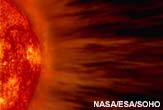
Carbon that has been locked away for thousands of years could escape into the atmosphere if global warming thaws large patches of frozen ground in Alaska and Siberia as expected, a new study warns.
Called permafrost, the frozen ground contains large amounts of carbon-rich grass and animal bones. The new study looked at the effects of global warming on permafrost in Siberia, called "yedoma."
Scientists calculate that about 500 gigatons (Gt) of carbon is locked away in yedoma permafrost. One gigaton is equal to one billion tons.
The researchers estimate that if global warming continues at its current pace, about 90 percent of the carbon in yedoma permafrost could be released. Most of it would go into the atmosphere as either carbon dioxide or methane, the researchers say.
The study, led by Sergey Zimov from the Russian Academy of Sciences, is detailed in the July 15 issue of the journal Science.
The study notes that about another 500 Gt of carbon is locked away in other permafrost areas around the world, and that global warming could have similar effects on these areas as well.
Scientists estimate that permafrost makes up some 24 percent of land in the Northern Hemisphere.
Sign up for the Live Science daily newsletter now
Get the world’s most fascinating discoveries delivered straight to your inbox.









